Joe Blevins's Blog, page 56
September 29, 2021
Ed Wood Wednesdays: The Ed Wood Summit Podcast #18 by Greg Dziawer
 This week, we'll learn some new things about Valda Hansen.
This week, we'll learn some new things about Valda Hansen.Despite appearing in only one of Ed Wood's movies, namely the supernatural thriller Night of the Ghouls (1959) , actress Valda Hansen remains one of the most beloved stars in the entire Wood coterie. This week on The Ed Wood Summit Podcast, it's my special privilege to talk about Valda with writer Robert Monell.
I've long been a fan of Robert's work, especially his writing on Euro exploitation films. He knew Valda before her untimely passing, and he shared stories and information heretofore unknown. Join us for a fascinating discussion!
I noted in our conversation that Valda won a beauty contest at a movie ranch and was selected Queen of Corriganville , right around the time she was working with Ed Wood. That's noted in the newspaper article featured here .
 From The Van Nuys News and Valley Green Sheet, August 14, 1958.
From The Van Nuys News and Valley Green Sheet, August 14, 1958.That article also mentions that Valda was working with Ed Wood on something called Trial by Error, surely a typo and referring to the ill-fated Trial by Terror .
Be sure to check out Robert Monell's great work here . And if you want more of The Ed Wood Summit Podcast, you can find all the past episodes right here .
Published on September 29, 2021 05:15
September 28, 2021
Podcast Tuesday: "Is This Even a Nostalgia Show Anymore?"
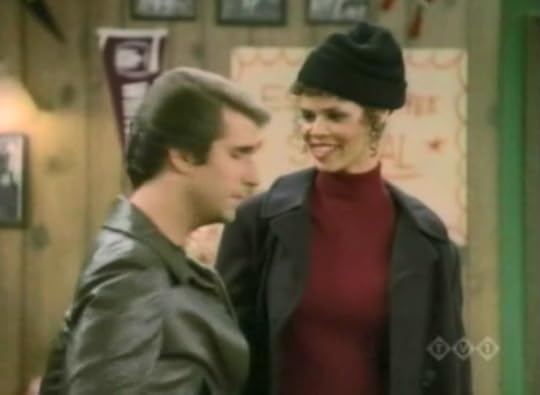 Henry Winkler and Deborah Pratt on Happy Days.
Henry Winkler and Deborah Pratt on Happy Days.Happy Days can trace its roots back to a fateful 1971 meeting between two TV executives, Paramount's Tom Miller and ABC's Michael Eisner, who were snowed in at the Newark Airport and decided to use that time to brainstorm a new series. Miller and Eisner decided that a nostalgia-themed show might be a good idea, since the clothes and hairstyles wouldn't look dated just a few years later in reruns. They handed off the idea to Odd Couple producer Garry Marshall, who decided to set it in the 1950s. A half-hour pilot aired in early 1972 as part of the anthology series Love American Style, but ABC passed on the project.
The very next year, however, the movie American Graffiti and the stage musical Grease proved that nostalgia could be a potential goldmine, so ABC regained interest in Marshall's series. Happy Days finally joined the network's prime time schedule in January 1974. By this point, it had already changed rather drastically from the original pilot. Cast members Ron Howard, Anson Williams, and Marion Ross remained, but they were joined by Tom Bosley, Erin Moran, Donny Most, and, perhaps most significantly, Henry Winkler as greaser mechanic Arthur "The Fonz" Fonzarelli, the epitome of cool. Also, while the pilot was set in the gentle, pre-rock years, the new, more raucous Happy Days was chockablock with oldies by Bobby Darin, Fats Domino, Bill Haley, and more.
Winkler's character ultimately became the focal point of the series, and Happy Days gradually moved away from its roots. In the first two seasons, the characters could barely get through a conversation without making references to fads, fashions, and pop culture icons of the 1950s. But this aspect of the show grew less and less important over time. After a few seasons, the action of the show was shifted to the early 1960s.
By 1979, Happy Days was in its seventh season and was scarcely recognizable as the show it once was. It bore only a passing resemblance to that Love American Style pilot. Apart from Fonzie's leather jacket and the oldies emanating from the jukebox, you could barely tell Happy Days was supposed to be taking place in any other time than the late '70s. A perfect example of this phenomenon is the episode "Fonzie Meets Kat" from September 25, 1979. The far-fetched plot involves a mysterious woman named Kat Mandu (Deborah Pratt) who breezes into Milwaukee from parts unknown and intervenes during a bar fight between Fonzie and a sailor named Rico (John Papais). None of this seems designed to evoke a sense of nostalgia in viewers, unless they spent a lot of time at dockside bars getting into martial arts battles.
But what did we think of "Fonzie Meets Kat"? You can find out by listening to the latest episode of These Days Are Ours: A Happy Days Podcast .
Published on September 28, 2021 05:04
September 22, 2021
Ed Wood Wednesdays: The Ed Wood Summit Podcast #17 by Greg Dziawer
 This week, Greg attempts to untangle another mystery about Ed Wood.
This week, Greg attempts to untangle another mystery about Ed Wood.It ain't easy trying to ID the adult paperbacks and magazine articles that Ed Wood may have written nearly 60 years ago. This is a largely neglected body of work, and the rabbit holes run deep (no pun intended).
Last week on The Ed Wood Summit Podcast, I took a dive down one of those rabbit holes with my friend and fellow Woodologist Rob Huffman . Together, we autopsied what might have been some of the earliest examples of Ed Wood's adult magazine work, dating back to the early 1960s. Some of you asked to see the actual texts, so this week, I'm doing the first ever Ed Wood Summit Podcast story time! The story "It Takes Four to Tangle" was identified many moons ago as possibly being Wood's work, and in this podcast, I'll read it out loud to you.
Have a listen and tell me what you think!
As a reminder, all episodes of The Ed Wood Summit Podcast are available here .
Published on September 22, 2021 05:21
September 21, 2021
Podcast Tuesday: "For Sale: One Soul, Never Used"
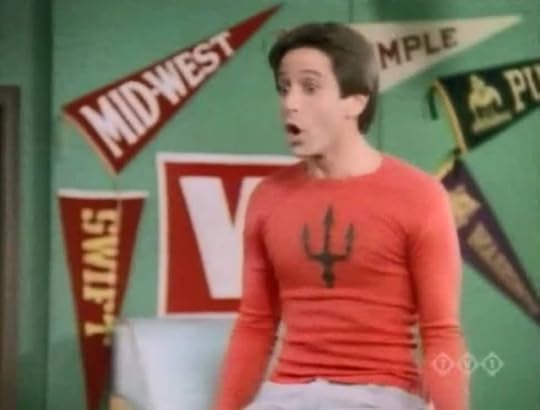 Richard Levin on Happy Days.
Richard Levin on Happy Days.There has to be one. If you have 255 episodes of a prime time American sitcom, one of those episodes will have to be the lowest-rated on the Internet Movie Database. In the case of Happy Days, it's the Season 7 episode "Chachi Sells His Soul," which first aired back on September 18, 1979 and which now rates a miserable 5.8 according to IMDb users. Does it deserve this dubious distinction?
Well, to be frank, this episode has a lot going against it. First of all, it's about Fonzie's smart-alecky cousin Chachi (Scott Baio), who has long been one of the more divisive characters on Happy Days. Secondly, it ventures into wild fantasy territory, with Chachi agreeing to sell his soul to a wisecracking demon named Melvin Scratch (Richard Levin) in exchange for being loved by the world. Third, it's basically a glorified commercial for another ABC sitcom, Out of the Blue, starring comedian Jimmy Brogan as an angel named Random trying to earn his wings on Earth.
But does that add up to "worst Happy Days episode of all time"? It's tough to say. It's a silly, gimmicky show, for sure, and many viewers will find Melvin annoying after a few minutes. He's a hyperactive, giggling nerd in the grand TV tradition of Horshack, Urkel, and Screech. Also, he wears very tiny shorts. In contrast, when the angel Random shows up near the end, he's so casual and low-energy that he barely makes an impact on the viewer. "Chachi Sells His Soul" is an obvious ripoff of the Season 5 classic "My Favorite Orkan," but neither Melvin nor Random is in the same league as Robin Williams' lovable alien Mork.
On the other hand, this episode certainly isn't boring. And it isn't overly sentimental and mawkish, the way Happy Days sometimes can be. There's a lot to unpack here. This week on These Days Are Ours: A Happy Days Podcast , we talk about all the good points and the bad points of "Chachi Sells His Soul." I really hope you'll join us.
Published on September 21, 2021 05:11
September 15, 2021
Ed Wood Wednesdays: The Ed Wood Summit Podcast #16 by Greg Dziawer with Rob Huffman
 This week, Greg and Rob explore Ed Wood's work for a company called France.
This week, Greg and Rob explore Ed Wood's work for a company called France.Ed Wood's fans know that their hero wrote numerous adult books, stories, and articles for Pendulum Publishing in the 1960s and '70s. Earlier this year, however, I stumbled upon an LA Weekly article by Tony Mostrom suggesting that Eddie also wrote for another adult publisher called France. According to Mostrom, Wood "penned cruddy porn paperbacks" for the company in the "dreary" early 1960s. Ed's work for France is much less known than his work for Pendulum, and I was eager to learn more about it.
I reached out to my friend and colleague Rob Huffman, who subsequently shared a few more details with me, gleaned from crime-fiction author John Gilmore's 2011 memoir Laid Bare . Rob then realized he had learned about Ed Wood working for France years ago, so we started digging for texts to review.
The results of our endeavor comprise this week's edition of The Ed Wood Summit Podcast.
During our conversation, Rob and I made our surmises about Red Garter #1, a magazine published by France (aka International Publications, Inc.) in 1962. You can find a scan of that magazine right here . What do you think? Is this the work of Edward D. Wood, Jr.? We have additional thoughts on this topic, so there will be much more to come!
Meanwhile, all episodes of The Ed Wood Summit Podcast can be found here .
Published on September 15, 2021 04:56
September 14, 2021
Podcast Tuesday: "Looking Down the Barrel of a Gun"
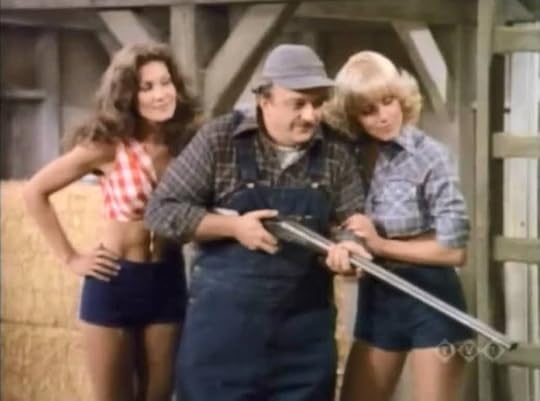 Vicki Frederick, F. William Parker, and April Clough on Happy Days.
Vicki Frederick, F. William Parker, and April Clough on Happy Days.Hubris. That's the only word for it. During the 1978-79 television season, ABC's Happy Days and its spinoffs dominated the prime time ratings. Laverne & Shirley was #1, while Happy Days itself was tied for third with Mork & Mindy. (Another ABC sitcom, Three's Company, was in second place.) Promisingly, the new show Angie, a romantic comedy from Happy Days producer Garry Marshall, was #5. All told, ABC had seven of the top 10 shows on television. Things were going great.
So what did ABC do for the 1979-80 season? Change it all up, naturally! The first order of business was breaking up the powerhouse one-two combo of Happy Days and Laverne & Shirley that had been such a ratings smash for years. Happy would retain its usual berth, Tuesday nights at 8:00, but Laverne would be moved to Thursdays, displacing Mork & Mindy to Sundays! And Angie, which had been retaining much of its lead-in from Mork on Thursdays, would be moved to Tuesdays, following Happy Days.
Confused yet? So were viewers. As a result of these schedule changes, Happy Days, Laverne & Shirley, Mork & Mindy, and Angie all plummeted from the Top 10, never to return. (Three's Company, which retained its usual Tuesdays at 9:00 slot, survived nicely.) ABC later came to its senses and reteamed Happy and Laverne, trying to undo some of the damage it had done. It kind of worked, and their ratings perked up a little without ever reaching their former highs. Angie couldn't be saved, however, and was canceled at the end of the season.
This week on These Days Are Ours: A Happy Days Podcast, we're covering "Shotgun Wedding," the first new episode of that tumultuous 1979-80 season. It's an epic crossover between Happy Days and Laverne & Shirley, the last time these two sibling shows would ever overlap. In fact, when it originally aired, "Shotgun Wedding" was in two parts. The story started on Happy Days on Tuesday, September 11, 1979 and then concluded on Laverne & Shirley on Thursday, September 13. However, for syndication purposes, Happy Days filmed an alternate ending so that its half of the story could be viewed as a standalone episode.
I know how complicated this all sounds. Believe me, we're just as befuddled as you are. But just listen to our podcast, and maybe together we can figure it out.
Published on September 14, 2021 04:41
September 8, 2021
Ed Wood Wednesdays, week 123: Bob Steele, the would-be Wood star
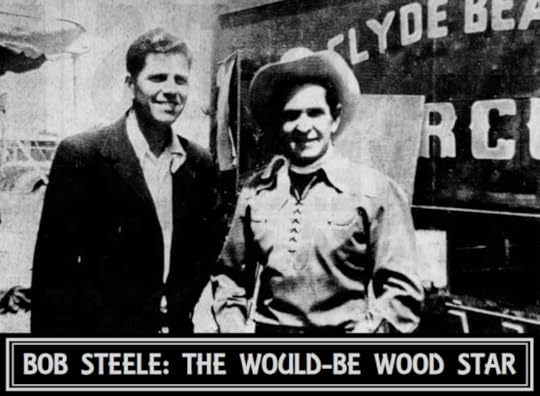 Bob Steele (right) with newspaper columnist Bill Soberanes.
Bob Steele (right) with newspaper columnist Bill Soberanes.Bob Steele (1907-1988) never appeared in any of Ed Wood's films or TV shows, but it wasn't for lack of trying. According to Rudolph Grey's Nightmare of Ecstasy: The Life and Art of Edward D. Wood, Jr. (1992), Eddie had two major unrealized projects involving Steele, a superhumanly prolific actor whose screen career spanned from 1920 to 1974.
Steele's story is an interesting one. A Portland native, he had been part of his family's vaudeville act since his early childhood. For his first few years in Hollywood, largely appearing in movies directed by his own father, he went by his real name, Bob Bradbury, Jr. In 1927, he started using the catchier name Bob Steele and stuck with it for the rest of his career.
Like Wood regulars Tom Keene and Kenne Duncan, Steele was best known for his work in modestly-budgeted Westerns. His main employers were poverty row studios like Monogram, Republic, and the lowly PRC. But the diminutive actor earned a fan following anyway, becoming a screen idol to a generation of matinee-attending kids. In The Hall of Fame of Western Film Stars (1969), author Ernest N. Corneau puts it this way:
A perennial favorite of Western fans, Bob has contributed a major portion of talent and skill toward the advancement of the Western genre. Audiences who saw him in action were never short changed when it came to thrills and excitement. Although unusually short in height for a cowboy hero, he proved himself quite capable of handling any rough stuff, whether it involved fisticuffs or stunt riding. He truly earned his title of "The Little Giant of Westerns."Ed Wood was undoubtedly one of Bob Steele's ardent admirers. In 1953, Wood envisioned "a series of low-budget Westerns" called Bob Steele of the Border Patrol. The text doesn't clarify if this was to be a TV series or a film franchise. Either way, it sounds a lot like Tom Keene, U.S. Marshall.
Grey does mention that Border Patrol was to be produced by a company called Commodore. I found only a couple of known Commodore titles: a 1953 Clyde Beatty adventure film called Perils of the Jungle and a Los Angeles TV talk show called Help Thy Neighbor in which host Hal Styles attempts to drum up donations for Los Angelinos with hard-luck stories. Both Perils of the Jungle and Help Thy Neighbor were produced by a man named , who also produced the iconic Hopalong Cassidy radio show (1948-1952) under the Commodore banner.
Bob Steele was also supposed to have appeared in Ed Wood's thwarted Western/horror hybrid, The Ghoul Goes West (aka The Phantom Ghoul). Between being namechecked in both Tim Burton's Ed Wood (1994) and Ted Newsom's Look Back in Angora (1994) and having its screenplay published in 2016 , The Ghoul Goes West is one of Ed's best-known unrealized projects. Eddie originally announced the film in 1953, but production was delayed by Bela Lugosi's stint in rehab. When Gene Autry dropped out of the movie in 1955, Eddie considered Bob Steele as a possible replacement before shelving the project altogether.
Admittedly, I have not seen enough B-grade Westerns of the 1930s and '40s to be that familiar with Bob Steele's cowboy career. As it turns out, however, I definitely have seen some of his more high-profile, mainstream pictures. You probably have, too. For instance, Bob played the villainous Curley in the 1939 version of Of Mice and Men starring Burgess Meredith and Lon Chaney, Jr. Bob's other credits include The Big Sleep (1946), Rio Bravo (1959), McClintock! (1963), and Hang 'Em High (1968). Steele never worked with Ed Wood, but he did work with such famed directors as Howard Hawks, Don Siegel, William Wellman, and Michael Curtiz. On the small screen, Steele was a regular on the '60s frontier comedy F Troop as Trooper Duffy and made appearances on many of the big shoot 'em up shows of the era: Gunsmoke, Rawhide, Maverick, etc. He did some non-Western shows, too, including Family Affair, Judd for the Defense, and Then Came Bronson.
Starting in the mid-1950s, Bob Steele transitioned mainly to television while making occasional motion pictures. In 1966, somewhat embarrassingly, The Los Angeles Times mistakenly declared Steele dead. It seems a rodeo star with the same name had passed away. The actor -- then 59, still working steadily, and supposedly in good health -- set the Times straight. They corrected the mistake in their July 15, 1966 edition with a rather lengthy article by staff writer Paul Henniger.
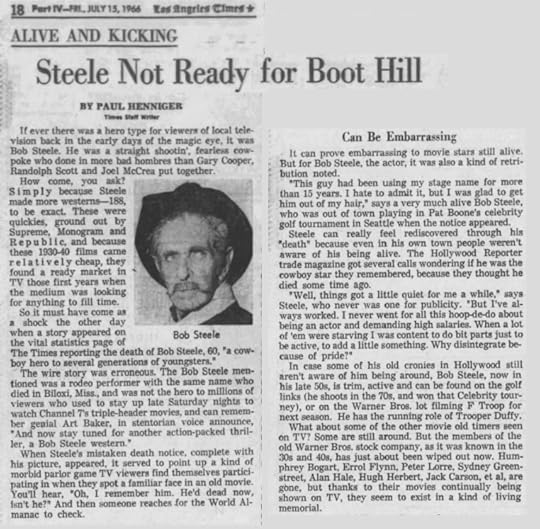 "I'm not dead!" declared Bob Steele.
"I'm not dead!" declared Bob Steele.A little later that same year, on October 16, 1966, the Petaluma Argus-Courier printed a long, flattering article by Bill Soberanes about Bob Steele, presenting him as the last man standing of the old-time Western stars, the ones who didn't need stuntmen. Note, too, that Steele worked with the aforementioned Clyde Beatty.
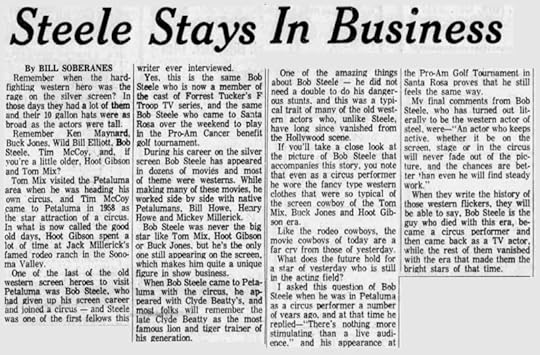 A flattering tribute to Bob Steele.
A flattering tribute to Bob Steele.As it turned out, Bob Steele kept working until 1974, finally ending his career with a supporting role in the somewhat forgotten thriller Nightmare Honeymoon starring Dack Rambo. He died on December 21, 1988 at the age of 81, having outlived his premature obituary by 22 and a half years. Touchingly, his actual obituary from the January 4, 1989 edition of the Petaluma Argus-Courier was also written by Bill Soberanes. (Despite what the article says, Steele was just shy of his 82nd birthday when he passed away.)
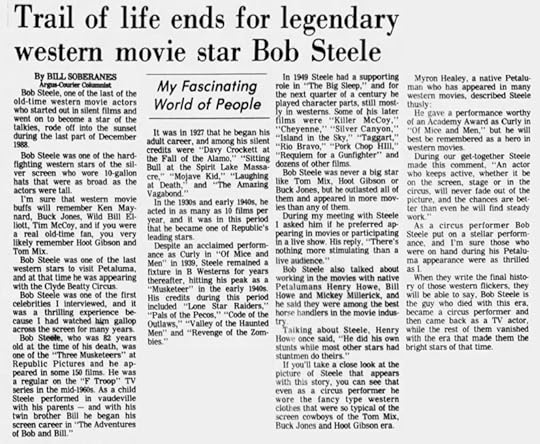 It was the end of the trail for Bob Steele.
It was the end of the trail for Bob Steele.We'll never know what magic (or anti-magic) Ed Wood and Bob Steele could have made together. Bob Steele of the Border Patrol would probably have been typical of Eddie's film and TV Westerns -- straightforward, moralistic, and a little on the bland side compared to, say, Glen or Glenda (1953). Ed Wood tended to rein in his eccentricities when he made cowboy pictures, such was his reverence for the genre. Meanwhile, The Ghoul Goes West remains one of the great "what if"s of Ed's entire career. We can only speculate what kind of movie might have resulted from that unfilmed, genre-hopping script.
Despite his extensive and varied filmography, Bob Steele is not an actor I would ever have noticed under normal circumstances. My dad was a great fan of cheapie Westerns and was a regular attendee of the Saturday matinees as a child. Perhaps he sat through a few Bob Steele pictures -- or a few dozen of them. If he were still around, I'd ask him. As it is, Bob remains an intriguing footnote in the career of Edward D. Wood, Jr.
Published on September 08, 2021 04:55
September 1, 2021
Ed Wood Wednesdays, week 122: Who was Scott Zimmerman?
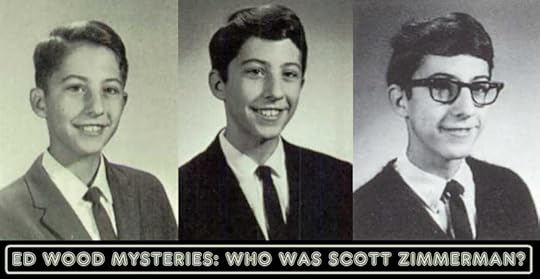 Scott Zimmerman of Cincinnati, OH as he appeared in (from left to right) 7th grade, 8th grade, and 9th grade.
Scott Zimmerman of Cincinnati, OH as he appeared in (from left to right) 7th grade, 8th grade, and 9th grade.Rudolph Grey interviewed dozens of subjects for his 1992 book Nightmare of Ecstasy: The Life and Art of Edward D. Wood, Jr. To tell the story of "the world's worst director" as fully as possible, Grey chatted with Ed Wood's friends, coworkers, and relatives -- a truly motley collection of human beings representing many walks of life. Most of the witnesses quoted in this book were in show business; some were not. But, even among this diverse group, Scott Zimmerman may be one of Nightmare's most unusual interviewees.
Scott is quoted twice in Nightmare of Ecstasy. The first such instance occurs on page 66, during the chapter on Bride of the Monster (1955). He talks about the establishing shots in Bride and whether the Old Willows Place was a real location.
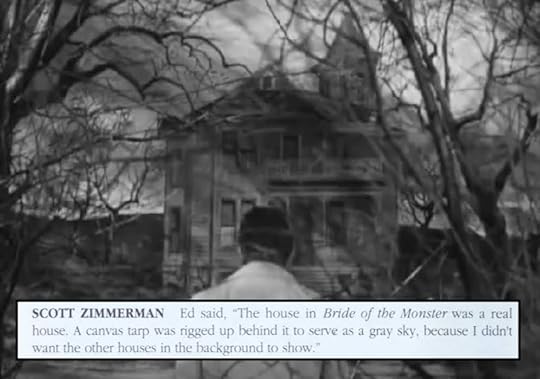 Scott Zimmerman discusses the establishing shots of the house in Bride of the Monster.
Scott Zimmerman discusses the establishing shots of the house in Bride of the Monster.A much, much longer quote from Scott Zimmerman appears on pages 121 and 122, as part of the chapter entitled "Weird Scenes with the Pied Piper." The chapter consists of people sharing anecdotes about Eddie's personality and lifestyle. We learn about his mercurial nature, his irresponsible spending, his love of partying, his arguments with his wife Kathy, his TV-watching obsession, his love of cowboy films (especially those of his idol, Buck Jones), and his notorious habit of calling people up in the middle of the night to talk about whatever was on his mind. Scott is one of those to contribute a story, which I will include in full because it is rich with details:
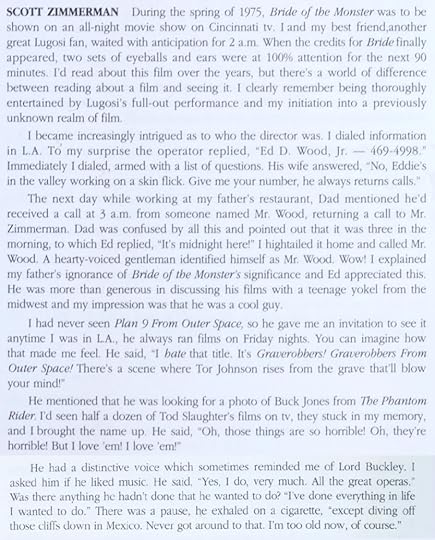 Scott Zimmerman reminisces about Ed Wood.
Scott Zimmerman reminisces about Ed Wood.Isn't that a great story? Scott Zimmerman was not in show business at all in 1975. He was just a nerdy teenager from Cincinnati who decided on a whim to call Ed Wood after watching Bride of the Monster on TV and ended up learning a lot about Eddie and his films in the process. This anecdote reminds me of what television personality Tom Bergeron has said about calling comedians Moe Howard and Larry Fine of The Three Stooges out of the blue circa 1972 and actually getting to interview them. Notice that Bergeron's story and Zimmerman's story both happened during the 1970s. I guess you could just call up your favorite stars back then, and it wasn't considered stalking.
Incidentally, I cannot pinpoint the exact TV showing that Zimmerman mentions. However, Bride of the Monster was broadcast numerous times in the 1970s, particularly in the late night hours on local stations across America (including Ohio). The movie was practically a staple of the small screen back then. I have every confidence that this part of Scott's story actually happened. Many Ed Wood fans were doubtlessly created by these after-hours broadcasts.
Here's a typical mid-1970s newspaper listing for Bride of the Monster, this one taken from the May 16, 1975 edition of The Casper (Wyoming) Star-Tribune. I found this same basic capsule summary, complete with Tor Johnson's name rendered as "Thor," in other papers of the era. Some substituted "mad scientist" for "weird wizard," but the rest of the wording was more or less the same.
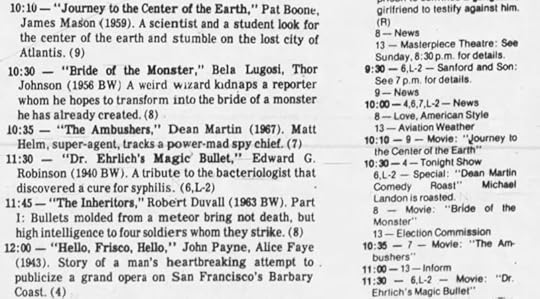 Bride of the Monster plays on TV in 1975.
Bride of the Monster plays on TV in 1975.But who exactly was Scott Zimmerman, other than a random fan who spoke with Ed Wood on the telephone in 1975? Unfortunately, Rudolph Grey does not supply any details about this mysterious man in the "Biographical Notes" section of the book. From pages 163 to 169, the book's main interviewees are listed alphabetically by last name and given brief descriptions. However, the final person named in that section is Mildred Worth, wife of Bride of the Monster composer Frank Worth. Sorry, Scott.
Grey does include Scott Zimmerman's name in the "Acknowledgements" section at the very end of the book. There, Scott is identified as one of those who provided "information, assistance and the use of valuable materials." I wonder how Grey knew to contact Scott in the first place? Could he have been following a lead from Kathy Wood? (Scott indicates that he spoke with Kathy before ever talking to Ed.)
Both Scott and Zimmerman are common names, so it figures that there are a lot of Scott Zimmermans out there in the world. How will we determine which of them was the Ed Wood fanatic? If our Scott was a teenager in 1975, that puts his birth somewhere between 1956 and 1962. We also know that Scott lived in the Cincinnati area, so that narrows it down even further. I found yearbook photos (included above) of a Scott Zimmerman who attended Finneytown High School in Cincinnati in the late 1960s. He seems to be a likely candidate. This skinny, gawky kid with the broad smile and prominent nose and ears looks like someone who might've stayed up late to watch Bela Lugosi in Bride of the Monster.
What happened to Scott Zimmerman? Did his love of movies cause him to pursue a career in Hollywood? Is he still alive today? Scott, if you're out there, let's talk. Alternately, if you're not Scott Zimmerman but have some details to share about him, let me know.
Published on September 01, 2021 05:08
August 31, 2021
Podcast Tuesday: "The Potsie Chase"
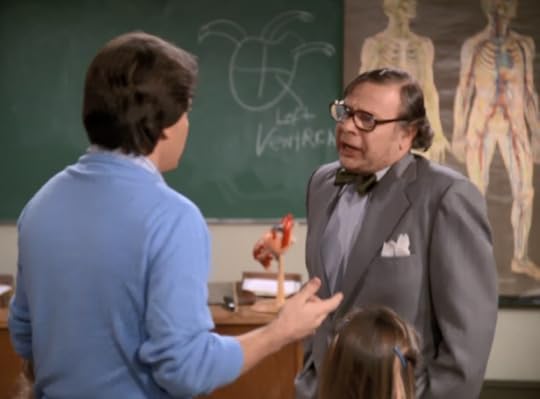 Anson Williams and Allan Rich on Happy Days.
Anson Williams and Allan Rich on Happy Days.Season 6 of Happy Days is bizarre. What other word can I use to describe it? These 27 episodes (airing between September 1978 and May 1979) vary wildly in tone from one week to the next. The show's writers seem to be trying every possible approach, from soapy melodrama ("Fonzie's Blindness," "Kid Stuff") to Saturday morning escapism ("The Claw Meets the Fonz," "Fonzie's Funeral"). What unites these stories? Really, only the dependable cast of regulars. I wonder if even they were confused by these scripts. Cowboys? Gangsters? An exorcism? What's going on here?
I don't mean to say that Season 6 is bad. In fact, I found it quite entertaining for the most part. But the series had lost all direction by this point. It isn't even particularly nostalgia-driven anymore, though there are still occasional golden oldies on the soundtrack and scattered references to TV shows and movies from the past. We're miles away from Season 1 and even further away from the original, quaint 1972 pilot. Interestingly, this was pretty much the end of Happy Days' stranglehold on American popular culture. The show would tumble from the Top 10 the next season, never to return.
This week on These Days Are Ours: A Happy Days Podcast , we're reviewing the Season 6 finale, "Potsie Quits School." The plot has hapless college student Potsie Weber (Anson Williams) confronting a stern, dictatorial anatomy professor (Allan Rich). It's my theory that this episode is the show's direct response to CBS' The Paper Chase, which was airing against Happy Days on Tuesday nights that year. Naturally, like most Potsie-centric episodes, this one features a big musical number, namely the immortal "Pump Your Blood."
I hope you'll join us for our review of "Potsie Quits School." This podcast also contains our overall thoughts on Season 6 and our picks for the Top 5 episodes of the year. Enjoy!
Published on August 31, 2021 04:57
August 25, 2021
Ed Wood Wednesdays: The Ed Wood Summit Podcast #15 by Greg Dziawer
 This week, Greg goes on an expedition of sorts.
This week, Greg goes on an expedition of sorts.We may never know the exact number of adult paperbacks Ed Wood wrote in the '60s and '70s. With a reasonable degree of certainty, we can attribute about 60 such books to Ed, including those written under his own name and those written under various pseudonyms. I've heard mention, however, that there may be more, perhaps many more!
In the massive ocean of tens of thousands of adult paperbacks, it's truly a daunting notion to know even where to begin.
In this week's edition of The Ed Wood Summit Podcast, I share some thoughts on how to drain that ocean into a shallow and narrow pool. And, as I did earlier this year , I go on a little fishing expedition, surveying a sampling of paperbacks put out by publishers who we know published work by Ed.
Just a reminder: all episodes of The Ed Wood Summit Podcast can be found right here .
Published on August 25, 2021 05:02



